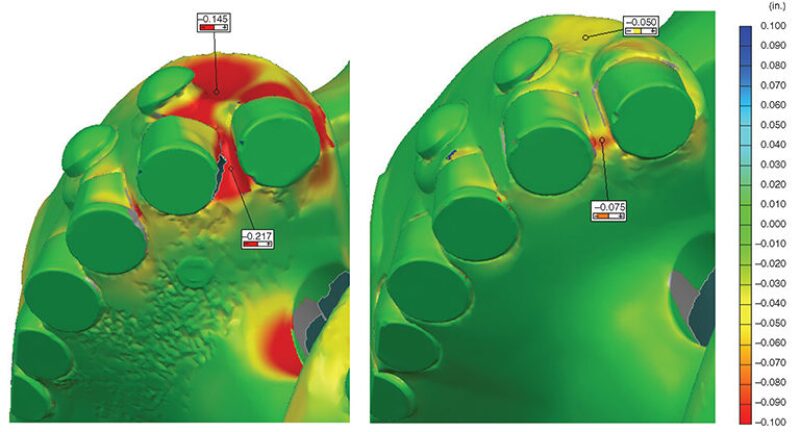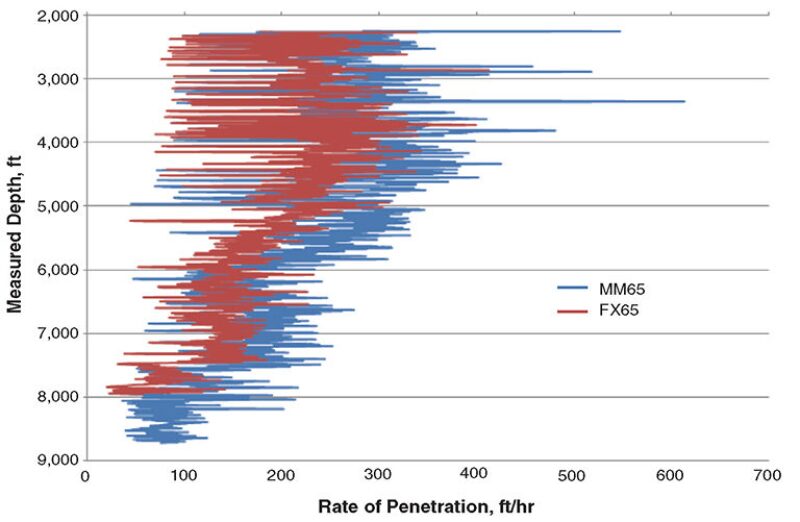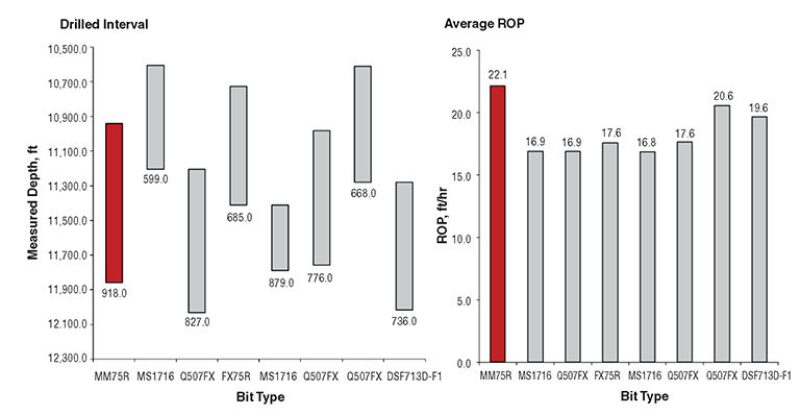Matrix body bits are known for longevity and reliability in challenging formations such as granite, chert, and abrasive sandstones and conglomerates. What is often missing from bit performance under these conditions is the ability to maintain a relatively high rate of penetration (ROP) while maximizing footage drilled in one run. The goal remains the same: Drill every interval in one run at the optimal ROP. In other words, the bit should not be the limiter when it comes to drilling performance.
Focusing on five key factors that contribute to ROP and longevity, a major bit supplier has designed a matrix body fixed-cutter bit that is setting records in a wide range of fields and formations. The whole is greater than the sum of the parts: The five new technologies comprising the design work to create a significantly higher standard of performance than is typically accepted for hard rock/abrasive rock drilling.
The examples following represent distinct formation types such as sand and shale intervals in the Rockies, limestone and sandstone in east Texas, the Granite Wash formation in the Texas Panhandle, and limestone and dolomite in the Permian Basin. All of these examples are laden with transition zones and most include conglomerate or other challenges to impact and abrasion resistance. The bits have been run in conventional and motor applications with equally good outcomes.
Five Performance Factors
Cutters. A critical improvement to the new bit design is the polycrystalline diamond compact (PDC) cutter technology. The proprietary interface design of the cutters used provides an extremely durable and efficient cutting element, removing significantly more rock with substantially less wear.
Furthermore, increased abrasion resistance in PDC cutters also increases the ability to withstand intense heat situations, contributing to thermal stability. While both thermally stable bits and abrasion-resistant bits perform similarly at the start of drilling, as cutter wear begins, the thermally stable products wear more slowly.
Ongoing research into wear mechanisms has optimized abrasion and impact resistance, and advanced the vital performance criterion of thermal mechanical integrity (TMI), or resistance to heat-generated wear. With greater TMI, the new cutters are highly TMI-qualified, able to withstand the extreme temperature cycling that occurs during drilling to provide greater strength and durability.
- The new cutters have enhanced abrasion resistance, so that the cutting edge remains sharp for a long time period, leading to a higher average ROP.
- The ability of the cutters to handle dynamic force is also improved, so that chipping and breakage along the cutter edge is minimized.
- Heat tolerance has been improved by strengthening the diamond-to-diamond bonds, allowing the cutters to endure the frictional heat generated by the drilling process. These cutters are well suited for high-temperature downhole environments.
These improvements go well beyond the mainstream emphasis on abrasion resistance. In the area of impact resistance alone, the new bits are providing approximately 40% higher achievement, with the new cutter helping extend performance capability, drilling up to four times the footage of the company’s previous products.
Matrix material. Erosion of the matrix material shortens bit life and alters hydraulic efficiency. An abrasive slurry at the bit face, coupled with the high flow rate typically needed for hole cleaning, can quickly initiate erosion in conventional matrix material.
The conventional matrix material (Fig. 1a) exhibits significant erosion of the cutting structure. The new materials, from matrix to binder, were developed and refined to address the demands of increased flow rates and pressures that accelerate erosion. Using a proprietary process, the tungsten carbide mix used in the new matrix material has been changed in order to yield better erosion properties while maintaining the strength of the materials. With the ability to refine particle size distribution, new binder material improves erosion resistance and strength, adding significant life to the bit without negatively affecting any other design elements. This new matrix material (Fig. 1b) exhibits almost zero erosion under the same conditions.

Multilevel force balancing. Loading can become unbalanced while drilling through different formations. The amount of formation removed by each cutter on a bit is different and, as a result, the force acting on each cutter also differs. Furthermore, the number of cutters differs from blade to blade; therefore, the forces acting on each blade differ. In order to avoid overloading individual cutters and blades, it is necessary to control these load distributions. To ensure that loading remains consistent during rock transitions, the cutters in the new bit designs are configured in groups to maintain balance and avoid breaking cutters. This improves drilling efficiency and maximizes the area of engagement on each cutter.
Enhanced hydraulics. The incorporation of “micro” nozzles allows for the strategic placement of nozzles in the new bit designs. The nozzle opening remains a standard size, but the housing or “packaging” is much smaller so that each nozzle occupies less space (Fig. 2).

In addition to increasing hydraulic design flexibility, the micro nozzles allow flow from each nozzle to be directed primarily out toward the junk slots with little recirculation. This optimizes bit cleaning by eliminating stagnant zones and helps minimize erosion. Cuttings are cleared rapidly, thus minimizing degradation.
Shank length. A key to optimizing directional bit design is engineering the distance between the bit face and the fulcrum point. Specifically, this distance and the cutting structure aggressiveness must be optimized to generate sufficient side force to achieve high dogleg curves. The bit-to-bend distance in the new bit design has been reduced by 14% to improve directional control and extend fatigue life in the connection.
Bit designs incorporating these combined technologies have consistently delivered penetration rates that exceed conventional or last-generation matrix bit performance in hard and abrasive formations.
Field Results
Uintah County, Utah
US Rocky Mountains
HDBS 7⅞-in. MM65 vs. FX65
Drilled 31% more footage at 20%
increase in ROP over the same section.
Improved dull condition to 1-1-WT.
In this Rocky Mountain well in Utah, the field benchmark performance of 7⅞-in. bits, shown in red (Fig. 3), was well established using the latest technology available. Introduction of the new bit technology incorporating the five design enhancements produced immediate performance improvements, with the MM65 bit drilling greater footage at a faster ROP and delivering a better dull grade than all previous designs.

Leon County, Texas
East Texas
HDBS 8¾-in. MM75R
Drilled in the Cotton Valley with 18%
increase in footage on best offset and
25% higher ROP on that offset.
In Leon County, Texas, 8¾-in. bit performance in the Bear Grass field had topped out in the Cotton Valley formation with a maximum footage of 827 ft at an average ROP of 20.6 ft/hr. Again, the introduction of the new enhanced design bits immediately exceeded that performance (Fig. 4, shown in red), drilling 918 ft at 22.1 ft/hr to establish new field benchmarks.

Wheeler County, Texas
Texas Panhandle
HDBS 6⅛-in. MM64D
18% increase in footage over best offset
while drilling in the Granite Wash.
In the Granite Wash formation of Wheeler County, Texas, notorious for hard drilling that limits footage in 6⅛-in. hole, an enhanced-design MM64D bit drilled a total footage of 3,940 ft to surpass the next best offset by 18% (Fig. 5).

In the Permian Basin too, where data from multiple wells are available for comparison (Fig. 6), the results show that the new bits are exceeding past field performance records in terms of footage drilled in a single run and average ROP. Over multiple runs in various Permian Basin fields, the enhanced “MegaForce” bits delivered as much as 12% greater footage and up to 24% faster ROP.

Fit-for-Purpose Design Capabilities
The success of the new evolution in matrix body bits reflects not only the incorporation of five new performance-enhancing technologies, but also the detailed input of expert field designers and their customers who collaborated to deploy the precise bit needed for every application.
Design should begin at the wellsite where conditions can be clearly observed and integrated into the design software. Operators participate in the process, bringing their observations and experience to bear. This differs from a centralized design group taking requests from field personnel, which may not produce a truly fit-for-purpose bit.
Wellsite design enables critical aspects to be modeled:
- The critical rev/min zones of the bit and bottomhole assembly (BHA) that might induce whirl, which needs to be avoided
- The weight on bit required by the drillstring to achieve the desired ROP at a given rev/min and in the calculated rock strength
- The amount of side force required by the bit from the BHA to make the required dogleg in the given formation
- The walk rate associated with the cutting structure and how that walk rate will work into tortuosity of the wellbore
- The reactive torque or tool face generated by the cutting structure and how it can best be controlled
The ability to analyze rock strength and lithology changes is also essential to optimizing drilling parameters in order to achieve the best ROP. Further, the wellsite design process could be adaptable to including a reamer in the BHA and calculating the split in weight on bit.
With these capabilities, the performance standards are understandably higher. The new bits are well equipped for severe abrasion, impact, and temperature challenges.
